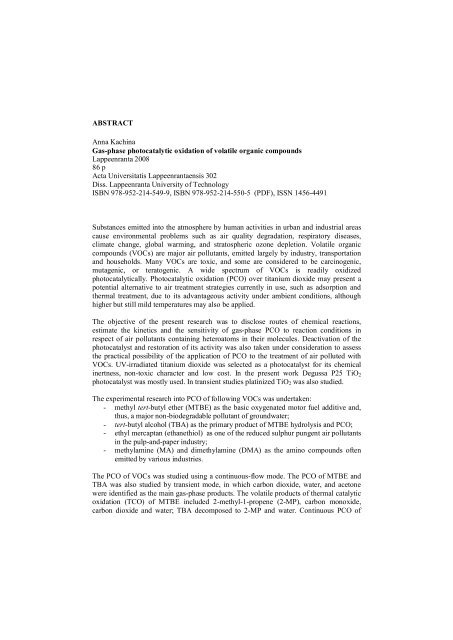gas-phase photocatalytic oxidation of volatile organic ... - Doria
gas-phase photocatalytic oxidation of volatile organic ... - Doria
gas-phase photocatalytic oxidation of volatile organic ... - Doria
You also want an ePaper? Increase the reach of your titles
YUMPU automatically turns print PDFs into web optimized ePapers that Google loves.
ABSTRACT<br />
Anna Kachina<br />
Gas-<strong>phase</strong> <strong>photocatalytic</strong> <strong>oxidation</strong> <strong>of</strong> <strong>volatile</strong> <strong>organic</strong> compounds<br />
Lappeenranta 2008<br />
86 p<br />
Acta Universitatis Lappeenrantaensis 302<br />
Diss. Lappeenranta University <strong>of</strong> Technology<br />
ISBN 978-952-214-549-9, ISBN 978-952-214-550-5 (PDF), ISSN 1456-4491<br />
3<br />
Substances emitted into the atmosphere by human activities in urban and industrial areas<br />
cause environmental problems such as air quality degradation, respiratory diseases,<br />
climate change, global warming, and stratospheric ozone depletion. Volatile <strong>organic</strong><br />
compounds (VOCs) are major air pollutants, emitted largely by industry, transportation<br />
and households. Many VOCs are toxic, and some are considered to be carcinogenic,<br />
mutagenic, or teratogenic. A wide spectrum <strong>of</strong> VOCs is readily oxidized<br />
<strong>photocatalytic</strong>ally. Photocatalytic <strong>oxidation</strong> (PCO) over titanium dioxide may present a<br />
potential alternative to air treatment strategies currently in use, such as adsorption and<br />
thermal treatment, due to its advantageous activity under ambient conditions, although<br />
higher but still mild temperatures may also be applied.<br />
The objective <strong>of</strong> the present research was to disclose routes <strong>of</strong> chemical reactions,<br />
estimate the kinetics and the sensitivity <strong>of</strong> <strong>gas</strong>-<strong>phase</strong> PCO to reaction conditions in<br />
respect <strong>of</strong> air pollutants containing heteroatoms in their molecules. Deactivation <strong>of</strong> the<br />
photocatalyst and restoration <strong>of</strong> its activity was also taken under consideration to assess<br />
the practical possibility <strong>of</strong> the application <strong>of</strong> PCO to the treatment <strong>of</strong> air polluted with<br />
VOCs. UV-irradiated titanium dioxide was selected as a photocatalyst for its chemical<br />
inertness, non-toxic character and low cost. In the present work Degussa P25 TiO2<br />
photocatalyst was mostly used. In transient studies platinized TiO2 was also studied.<br />
The experimental research into PCO <strong>of</strong> following VOCs was undertaken:<br />
- methyl tert-butyl ether (MTBE) as the basic oxygenated motor fuel additive and,<br />
thus, a major non-biodegradable pollutant <strong>of</strong> groundwater;<br />
- tert-butyl alcohol (TBA) as the primary product <strong>of</strong> MTBE hydrolysis and PCO;<br />
- ethyl mercaptan (ethanethiol) as one <strong>of</strong> the reduced sulphur pungent air pollutants<br />
in the pulp-and-paper industry;<br />
- methylamine (MA) and dimethylamine (DMA) as the amino compounds <strong>of</strong>ten<br />
emitted by various industries.<br />
The PCO <strong>of</strong> VOCs was studied using a continuous-flow mode. The PCO <strong>of</strong> MTBE and<br />
TBA was also studied by transient mode, in which carbon dioxide, water, and acetone<br />
were identified as the main <strong>gas</strong>-<strong>phase</strong> products. The <strong>volatile</strong> products <strong>of</strong> thermal catalytic<br />
<strong>oxidation</strong> (TCO) <strong>of</strong> MTBE included 2-methyl-1-propene (2-MP), carbon monoxide,<br />
carbon dioxide and water; TBA decomposed to 2-MP and water. Continuous PCO <strong>of</strong>

















